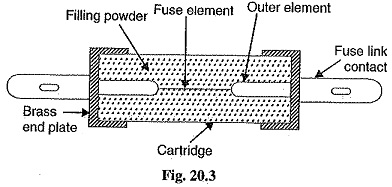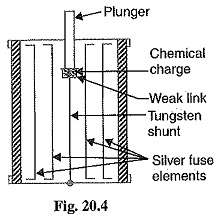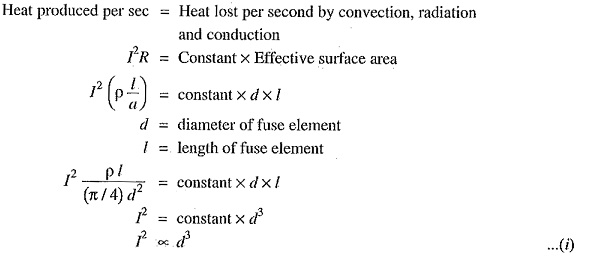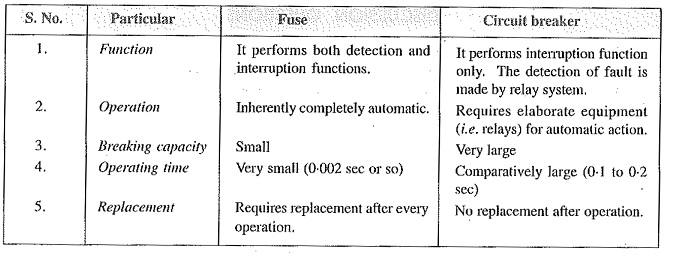Types of Fuses:
Fuse is the simplest current interrupting device for protection against excessive currents. Since the invention of first fuse by Edison, several improvements have been made and now-a-days, a variety of Types of Fuses are available. Some fuses also incorporate means for extinguishing the arc that appears when the fuse element melts. In general, Types of Fuses may be classified into :
-
Low voltages fuses
-
High voltage fuses
It is a usual practice to provide isolating switches in series with fuses where it is necessary to permit fuses to be replaced or rewired with safety. If such means of isolation are not available, the Types of Fuses must be so shielded as to protect the user against accidental contact with the live metal when the fuse carrier is being inserted or removed.
Low Voltage Fuses:
Low voltage fuses can be subdivided into two classes viz.,
-
Semi-enclosed rewireable fuse
-
High rupturing capacity (H.R.C.) cartridge fuse.
1. Semi-enclosed Rewireable fuse: Rewireable fuse (also known as kit-kat type) is used where low values of fault current are to be interrupted. It consists of (i) a base and (ii) a fuse carrier. The base is of porcelain and carries the fixed contacts to which the incoming and outgoing phase wires are connected. The fuse carrier is also of porcelain and holds the Types of Fuses element (tinned copper wire) between its terminals. The fuse carrier can be inserted in Of taken out of the base when desired.
When a fault occurs, the fuse element is blown out and the circuit is interrupted. The fuse carrier is taken out and the blown out fuse element is replaced by the new one. The fuse carrier is then reinserted in the base to restore the supply. This type of fuse has two advantages. Firstly, the detachable fuse carrier permits the replacement of Types of Fuses element without any danger of coming in contact with live parts. Secondly, the cost of replacement is negligible.
Disadvantages
- There is a possibility of renewal by the fuse wire of wrong size or by improper material.
- This type of fuse has a low-breaking capacity and hence cannot be used in circuits of high fault level.
- The fuse element is subjected to deterioration due, to oxidation through the continuous heating up of the element. Therefore, after some time, the current rating of the fuse is decreased e., the fuse operates at a lower current than originally rated.
- The protective capacity of such a Types of Fuses is uncertain as it is affected by the ambient conditions.
- Accurate calibration of the fuse wire is not possible because fusing current very much depends upon the length of the fuse element.
Semi-enclosed rewireable fuses are made up to 500 A rated current, but their breaking capacity is low e.g., on 400 V service, the breaking capacity is about 4000 A. Therefore, the use of this Types of Fuses is limited to domestic and lighting loads.
2. High-Rupturing capacity (H.R.C.) cartridge fuse: The primary objection of low and uncertain breaking capacity of semi-enclosed rewireable fuses is overcome in H.R.C. cartridge fuse. Fig. 20.3 shows the essential parts of a typical H.R.C. cartridge fuse. It consists of a heat resisting ceramic body having metal end-caps to which is welded silver cuirent-carrying element. The space within the body surrounding the element is completely packed with a filling powder. The filling material may be chalk, plaster of paris, quartz or marble dust and acts as an arc quenching and cooling medium.
Under normal load conditions, the fuse element is at a temperature below its melting point.
Therefore, it carries the normal current without overheating. When a fault occurs, the current increases and the fuse element melts before the fault current reaches its first peak. The heat produced in the process vaporizes the melted silver element The chemical reaction between the silver vapour and the filling powder results in the formation of a high resistance substance which helps in quenching the arc.
Advantages
- They are capable of clearing high as well as lo
- They do not deteriorate with age.
- They have high speed of operation.
- They provide reliable discrimination.
- They require no maintenance.
- They are cheaper than other circuit interrupting devices of equal breaking capacity.
- They permit consistent performance.
Disadvantages
- They have to be replaced after each operation.
- Heat produced by the arc may affect the associated switches.
3.H.R.C. fuse with tripping device: Sometime, H.R.C. cartridge fuse is provided with a tripping device. When the fuse blows out under fault conditions, the tripping device causes the circuit breaker to operate. Fig. 20.4 shows the essential parts of a H.R.C. fuse within tripping device. The body of the fuse is of ceramic material with a metallic cap rigidly fixed at each end. These are connected by a number of silver fuse elements. At one end is a plunger which under fault conditions hits the tripping mechanism of the circuit breaker and causes it to operate. The plunger is electrically connected through a fusible link, chemical charge and a tungsten wire to the other end of the cap as shown.
When a fault occurs, the silver fuse elements are the first to be blown out and then current is transferred to the tungsten wire. The weak link in series with the tungsten wire gets fused and causes the chemical charge to be detonated. This forces the plunger outward to operate the circuit breaker, The travel of the plunger is so set that it is not ejected from the fuse body under fault conditions.
Advantages: H.R.C. fuse with a tripping device has the following advantages over a H.R.C. fuse without tripping device:
- In case of a single phase fault on a three-phase system, the plunger operates the tripping mechanism of circuit breaker to open all the three phases and thus prevents “single phas Mg”.
- The effects of full short circuit Gwent need not be considered in the choice of circuit breaker. This permits the use of a relatively inexpensive circuit breaker.
- The fuse-tripped circuit breaker is generally capable of dealing with fairly small fault currents itself. This avoids the necessity for replacing the fuse except after highest currents for which it is intended.
Low voltage H.R.C. fuses may be built with a breaking capacity of 16,000 A to 30,000 A at 440V. They are extensively used on low-voltage distribution system against over-load and short-circuit conditions.
High Voltage Fuses:
The low-voltage fuses discussed so far have low normal current rating and breaking capacity. Therefore, they cannot be successfully used on modern high voltage circuits. Intensive research by the manufacturers and supply engineers has led to the development of high voltage fuses. Some of the high voltage fuses are :
1. Cartridge type: This is similar in general construction to the low voltage cartridge type except that special design features are incorporated. Some designs employ fuse elements wound in the form of a helix so as to avoid corona effects at higher voltages. On some designs, there are two fuse elements in parallel ; one of low resistance (silver wire) and the other of high resistance (tungsten wire). Under normal load conditions, the low resistance element carries the normal current. When a fault occurs, the low-resistance element is blown out and the high resistance element reduces the short-circuit current and finally breaks the circuit.
High voltage cartridge fuses are used upto 33 kV with breaking capacity of about 8700 A at that voltage. Rating of the order of 200 A at 6.6 kV and 11 kV and 50 A at 33 kV are also available.
2. Liquid type: These Types of Fuses are filled with carbon tetrachloride and have the widest range of application to h.v. systems. They may be used for circuits upto about 100 A rated current on systems upto 132 kV and may have breaking capacities of the order of 6100 A.
Fig. 20.5 shows the essential parts of the liquid fuse. It consists of a glass tube filled with carbon tetrachloride solution and sealed at both ends with brass caps. The fuse wire is sealed at one end of the tube and the other end of the wire is held by a strong phosphor bronze spiral spring fixed at the other end of the glass tube. When the current exceeds the prescribed limit, the fuse wire is blown out. As the fuse melts, the spring retracts part of it through a baffle (or liquid director) and draws it well into the liquid. The small quantity of gas generated at the point of fusion forces some part of liquid into the passage through baffle and there it effectively extinguishes the arc.
3. Metal clad fuses: Metal clad oil-immersed fuses have been developed with the object of providing a substitute for the oil circuit breaker. Such Types of Fuses can be used for very high voltage circuits and operate most satisfactorily under short-circuit conditions approaching their rated capacity.
Current Carrying Capacity of Fuse Element:
The current carrying capacity of a fuse element mainly depends on the metal used and the cross-sectional area but is affected also by the length, the state of surface and the surroundings of the fuse. When the fuse element attains steady temperature,
Expression (i) is known as ordinary fuse law.
Difference Between a Fuse and Circuit Breaker:
The Difference Between a Fuse and Circuit Breaker are shown in the below tabular form.




